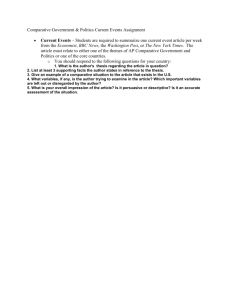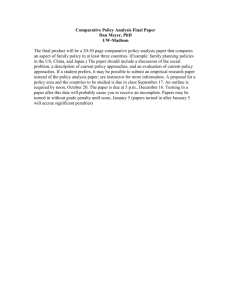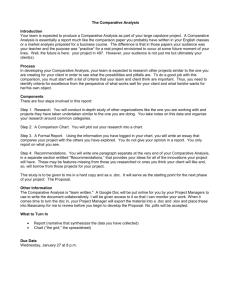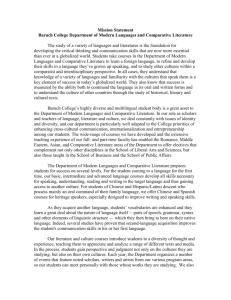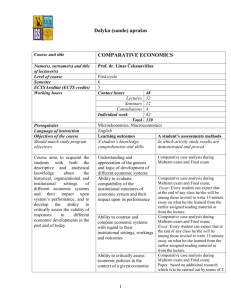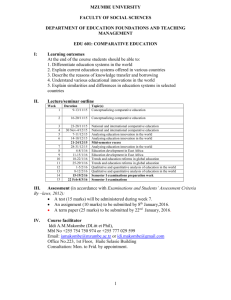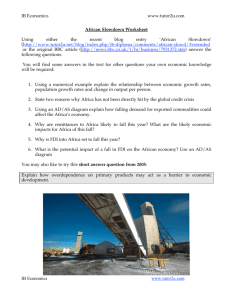A2 Economics Comparative Advantage and Benefits of
advertisement
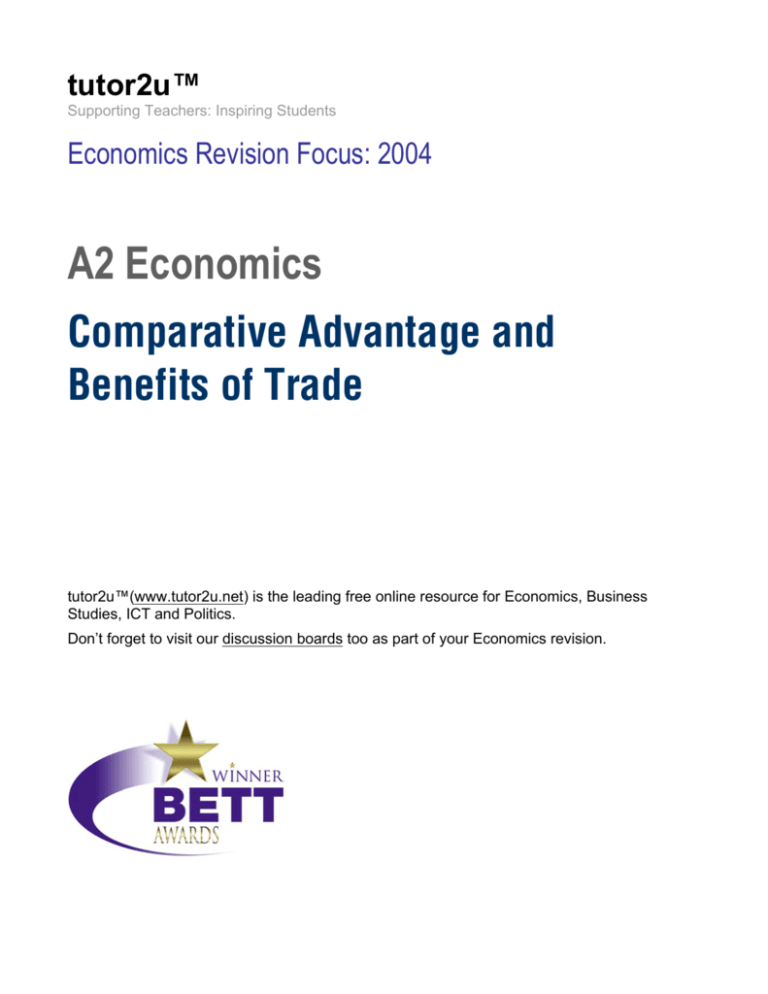
tutor2u™ Supporting Teachers: Inspiring Students Economics Revision Focus: 2004 A2 Economics Comparative Advantage and Benefits of Trade tutor2u™(www.tutor2u.net) is the leading free online resource for Economics, Business Studies, ICT and Politics. Don’t forget to visit our discussion boards too as part of your Economics revision. tutor2u™ Supporting Teachers: Inspiring Students Page 2 of 6 Comparative Advantage and Benefits of Trade Revision Focus on Comparative Advantage and Benefits of Trade (A2) A2 Syllabus Requirements Candidates should understand the model of comparative advantage and be able to evaluate its importance and limitations Candidates should understand the benefits of international trade illustrated by the principle of comparative advantage and also be able to explain other costs and benefits that are associated with trade between nations. If there is one proposition with which virtually all economists agree, it is that free trade is almost always better than protection. In essence, the theory of comparative advantage says that it pays countries to trade because they are different. (The Economist, May 1998) The concept of comparative advantage First introduced by David Ricardo in 1817, comparative advantage exists when a country has a ‘margin of superiority’ in the production of a good or service i.e. where the marginal cost of production is lower. Countries will usually specialise in and then export products, which use intensively the factors inputs, which they are most abundantly endowed. If each country specialises in those goods and services where they have an advantage, then total output can be increased leading to an improvement in allocative efficiency and economic welfare This is true even if one nation has an absolute advantage over another country. So for example the Canadian economy which is rich in low cost land is able to exploit this by specialising in agricultural production. The dynamic Asian economies including China have focused their resources in exporting lowcost manufactured goods which take advantage of much lower unit labour costs. In highly developed countries, the comparative advantage is shifting towards specialising in producing and exporting high-value and high-technology manufactured goods and high-knowledge services. Comparative advantage for the UK Balance of payments data for Britain indicate the changes in our net exports of goods and services with other countries. The UK’s comparative advantage now lies in the following areas: oil, chemicals & pharmaceuticals, aerospace and medical technology, insurance, financial services, computer services & software, other business services, and entertainment. We have lost much if not all of our comparative advantage in textiles, steel, coal and many other areas of traditional manufacturing industry where we run structural trade deficits. Worked example of comparative advantage Consider two countries producing two products – digital cameras and vacuum cleaners. With the same factor resources evenly allocated by each country to the production of both goods, the production possibilities are as shown in the table below. www.tutor2u.net : The Home of Economics on the Internet tutor2u™ Supporting Teachers: Inspiring Students Comparative Advantage and Benefits of Trade Page 3 of 6 Pre-specialisation Digital Cameras UK 600 United States 2400 Total 3000 Working out the comparative advantage Vacuum Cleaners 600 1000 1600 To identify which country should specialise in a particular product we need to analyse the internal opportunity costs for each country. For example, were the UK to shift more resources into higher output of vacuum cleaners, the opportunity cost of each vacuum cleaner is one digital television. For the United States the same decision has an opportunity cost of 2.4 digital cameras. Therefore, the UK has a comparative advantage in vacuum cleaners. If the UK chose to reallocate resources to digital cameras the opportunity cost of one extra camera is still one vacuum cleaner. But for the United States the opportunity cost is only 5/12ths of a vacuum cleaner. Thus the United States has a comparative advantage in producing digital cameras because its opportunity cost is lowest. According to the principle of comparative advantage, each country specializes in the products in which it has an advantage. Output after Specialisation Digital Cameras 0 (-600) 3360 (+960) 3000 3360 UK United States Total Vacuum Cleaners 1200 (+600) 600 (-400) 1600 1800 The UK specializes totally in producing vacuum cleaners – doubling its output to 1200 The United States partly specializes in digital cameras increasing output by 960 having given up 400 units of vacuum cleaners As a result of specialisation according to the principle of comparative advantage, output of both products has increased - representing a gain in economic welfare. For mutually beneficial trade to take place, the two nations have to agree an acceptable rate of exchange of one product for another. There are gains from trade between the two countries. If the two countries trade at a rate of exchange of 2 digital cameras for one vacuum cleaner, the post-trade position will be as follows: The UK exports 420 vacuum cleaners to the USA and receives 840 digital cameras The USA exports 840 digital cameras and imports 420 vacuum cleaners Post trade output / consumption UK United States Total Digital Cameras 840 2520 Vacuum Cleaners 780 1020 3360 1800 www.tutor2u.net : The Home of Economics on the Internet tutor2u™ Supporting Teachers: Inspiring Students Page 4 of 6 Comparative Advantage and Benefits of Trade Compared with the pre-specialisation output levels, consumers in both countries now have an increased supply of both goods to choose from. Assumptions behind Trade Theory This theory of the potential benefits from trade and exchange using the law of comparative advantage is based on a number of underlying assumptions: 1. Perfect occupational mobility of each of the factors of production (land, labour, capital etc.) -this means that switching factor resources from one industry to another involves no loss of relative efficiency and productivity. In reality of course we know that factors of production are not perfectly mobile – labour immobility for example is a root cause of structural unemployment 2. Constant returns to scale (i.e. doubling the inputs used in the production process leads to a doubling of output) – this is merely a simplifying assumption. Specialisation might lead to diminishing returns in which case the economic benefits from trade are reduced. Conversely, increasing the scale of production can generate increasing returns to scale - in which case the benefits from trade are even stronger than the numerical example we have considered 3. No externalities arising from production and/or consumption – meaning that there is no divergence between private and social costs and benefits. Again this is a simplifying assumption. No discussion about the overall costs and benefits of specialisation and trade should ignore many of the environmental considerations arising from increased production and trade between countries. 4. Zero or insignificant transportation costs What Determines Comparative Advantage? A country's place in the global economy seems neither predestined nor predictable. Comparative advantage is almost impossible to spot in advance. The Economist, April 2004 www.tutor2u.net : The Home of Economics on the Internet tutor2u™ Supporting Teachers: Inspiring Students Page 5 of 6 Comparative Advantage and Benefits of Trade Comparative advantage is best viewed as a dynamic concept meaning that it can and does change over time. Some businesses find they have enjoyed a comparative advantage within their own market in one product for several years only to face increasing competition as rival producers from other countries enter their markets and under cut them on price or take market share through non-price competition. For a country, the following factors are often seen as important in determining the relative costs of production: 1. The quantity and quality of factors of production available (e.g. the size and efficiency of the available labour force and the productivity of the existing stock of capital inputs) 2. Investment in research & development (this is important in industries where patents give some firms a significant market advantage) – there is quite strong evidence that an emerging comparative advantage often comes from entrepreneurial trial and error – the never ending process of engaging in research and innovation to find more efficient process and new products 3. Fluctuations in the real exchange rate which then affect the relative prices of exports and imports and cause changes in demand from domestic and overseas customers 4. Import controls such as tariffs, export subsidies and quotas can be used to create an artificial comparative advantage for a country's domestic producers 5. The non-price competitiveness of producers (e.g. covering factors such as the standard of product design and innovation, product reliability, quality of after-sales support) Comparative advantage is often a self-reinforcing process. Entrepreneurs in a country develop a new comparative advantage in a product (either because they find ways of producing it more efficiently or they create a genuinely new product that finds a growing demand in home and international markets). Rising demand and output encourages the exploitation of economies of scale; higher profits can be reinvested in the business to fund further product development, marketing and a wider distribution network. Skilled labour is attracted into the industry and so on. The wider benefits of international trade One way of expressing the gains from trade in goods and services between countries is to distinguish between the static gains from trade (i.e. improvements in allocative and productive efficiency) and the dynamic gains (the gains in welfare that occur over time from improved product quality, increased choice and a faster pace of innovative behaviour) Some of the broader gains from free trade are outlined below: 1. Welfare gains – allocative efficiency: Free trade can be shown under certain conditions to lead to significant increases in economic welfare. Neo-liberal economists who support the liberalisation of trade between countries believe that trade is a ‘positive-sum game’ – in other words, all counties engaged in open trade and exchange stand to gain. 2. Economies of scale - trade allows firms to exploit scale economies by operating in larger markets. Economies of scale lead to lower average costs of production that can be passed onto consumers. 3. Competition / market contestability – trade promotes increased competition particularly for those domestic monopolies that would otherwise face little real competition. For example, Corus faces competition from overseas steel producers and is effectively a price-taker in the world www.tutor2u.net : The Home of Economics on the Internet tutor2u™ Supporting Teachers: Inspiring Students Page 6 of 6 Comparative Advantage and Benefits of Trade market. The Royal Mail will have to fight hard to maintain its market position during the phased liberalization of the European postal services market between now and 2007. 4. Dynamic efficiency gains from innovation - trade also enhances consumer choice and international competition between suppliers help to keep prices down. Trade in ideas stimulates product and process innovations that generates better products for consumers and enhances the overall standard of living. 5. Rising living standards and a reduction in poverty - James Wolfeson (the Head of the World Bank) has argued that trade can be a powerful force in reducing poverty and raising living standards. A growing body of evidence shows that countries that are more open to trade grow faster over the long run than those that remain closed. And growth directly benefits the world's poor. A one percentage point increase in growth on average reduces poverty by more than 1.5 per cent each year. www.tutor2u.net : The Home of Economics on the Internet
